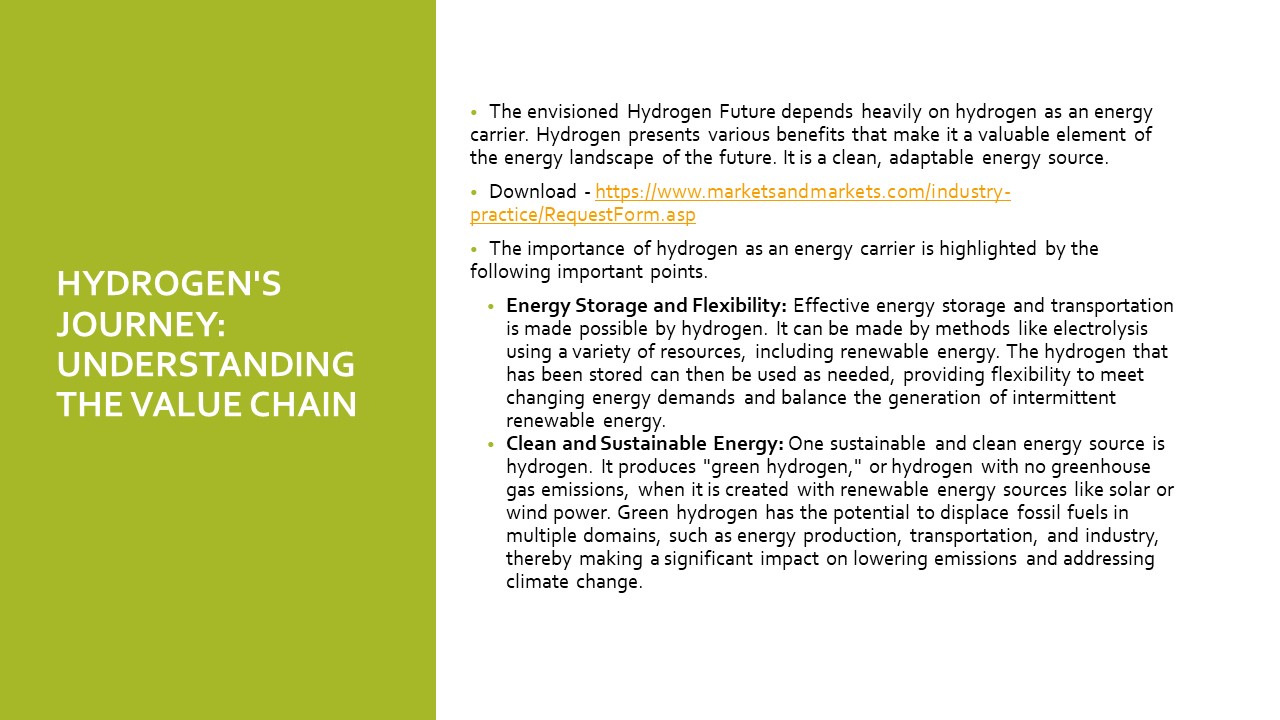Hydrogen's Journey: Understanding the Value Chain - PowerPoint PPT Presentation
Title:
Hydrogen's Journey: Understanding the Value Chain
Description:
The envisioned Hydrogen Future depends heavily on hydrogen as an energy carrier. Hydrogen presents various benefits that make it a valuable element of the energy landscape of the future. It is a clean, adaptable energy source. – PowerPoint PPT presentation
Number of Views:0
Title: Hydrogen's Journey: Understanding the Value Chain
1
Hydrogen's Journey Understanding the Value Chain
- The envisioned Hydrogen Future depends heavily on
hydrogen as an energy carrier. Hydrogen presents
various benefits that make it a valuable element
of the energy landscape of the future. It is a
clean, adaptable energy source. - Download - https//www.marketsandmarkets.com/indus
try-practice/RequestForm.asp - The importance of hydrogen as an energy carrier
is highlighted by the following important points.
- Energy Storage and Flexibility Effective energy
storage and transportation is made possible by
hydrogen. It can be made by methods like
electrolysis using a variety of resources,
including renewable energy. The hydrogen that has
been stored can then be used as needed, providing
flexibility to meet changing energy demands and
balance the generation of intermittent renewable
energy. - Clean and Sustainable Energy One sustainable and
clean energy source is hydrogen. It produces
"green hydrogen," or hydrogen with no greenhouse
gas emissions, when it is created with renewable
energy sources like solar or wind power. Green
hydrogen has the potential to displace fossil
fuels in multiple domains, such as energy
production, transportation, and industry, thereby
making a significant impact on lowering emissions
and addressing climate change.
2
- Versatility and Sector Integration Hydrogen is
incredibly versatile in a variety of industries.
It can be utilized in fuel cells to provide
electricity for portable, stationary, and transit
needs. In industrial operations, hydrogen can
also be used in place of fossil fuels as a
feedstock and source of heat. Hydrogen can also
assist in power generation by storing energy and
balancing the system. - Decarbonization Potential Decarbonization has
enormous potential in the hydrogen future.
Hydrogen has the potential to drastically cut
greenhouse gas emissions and air pollution by
substituting fossil fuels in a number of areas.
It helps accomplish ambitious climate targets and
facilitates the shift to a low-carbon economy. - Technological Advancements and Cost Reduction
Costs are being reduced by continuous
improvements in hydrogen technologies, such as
fuel cells and electrolysis, as well as economies
of scale. The cost of producing, storing, and
using hydrogen is anticipated to drop much more
as these technologies advance and become
economically viable. Future widespread use of
hydrogen as an energy carrier will be facilitated
by this cost reduction in addition to investments
and policies that encourage it.
3
Hydrogen Value Chain
- The process of producing, distributing, and using
hydrogen as an energy carrier is known as the
"Hydrogen Value Chain." Particularly for
industries like power generation, transportation,
and industry, hydrogen has drawn a lot of
attention as a potential clean and sustainable
energy source. - The hydrogen value chain typically consists of
the following stages - Hydrogen Production
- Natural Gas Reforming (Steam Methane Reforming,
SMR) With this technique, natural gas is
chemically transformed into hydrogen and carbon
dioxide. - Electrolysis Water is electrolyzed to separate
its hydrogen and oxygen molecules. It can
generate green hydrogen using renewable energy
sources. - Biomass Gasification Gasification is a method
that can be used to transform biomass into
hydrogen. - Thermochemical Water Splitting It is possible to
separate water into hydrogen and oxygen using
high-temperature heat. - Hydrogen Purification and Compression After
hydrogen is created, it frequently needs to be
compressed and filtered in order to meet quality
and pressure requirements for a variety of uses.
4
- Hydrogen Storage Gaseous, liquid, or solid state
hydrogen is usually stored in order to guarantee
its availability for usage when needed.
High-pressure containers, cryogenic storage, and
chemical hydrides are typical storage techniques. - Hydrogen Transportation Transporting hydrogen
from producing locations to end users can be
necessary. Pipelines, vehicles, or ships can
accomplish this, according on the necessary
quantity and distance. - Hydrogen Distribution Infrastructure for
distribution is necessary to provide end
consumers with hydrogen. This could entail
building pipes for industrial customers or a
network of hydrogen filling stations for
vehicles. - Hydrogen Utilization Numerous applications exist
for hydrogen, such as - Transportation hydrogen-powered buses, trucks,
and trains fuel cell vehicles (FCVs). - Industry The creation of chemicals, metals, and
refining are just a few of the industrial
operations that employ hydrogen. - Power Generation Fuel cells may produce
electricity using hydrogen, serving as a backup
power supply as well as a stationary power plant. - Residential and Commercial Heating Both houses
and businesses can utilize hydrogen for cooking
and heating. - Emissions Reduction Hydrogen's main selling
point is its ability to lower greenhouse gas
emissions, particularly when it is produced with
green hydrogena hydrogen derived from renewable
energy sources. In order to mitigate climate
change, fossil fuels are replaced in a variety of
applications.
5
- Hydrogen Recycling and Reuse Reusing and
recycling hydrogen makes it a sustainable energy
source according to the idea of a circular
hydrogen economy. Losses in the value chain can
be reduced by recycling and collecting hydrogen. - Research and Development To increase the
effectiveness, affordability, and safety of
hydrogen generation, storage, and usage systems,
ongoing research and development is necessary. - The value chain for hydrogen is still developing
as a result of continuous advancements in
science, legislation, and funding meant to expand
the use of hydrogen in the long run for
sustainable energy. A number of variables,
including local energy laws, environmental
objectives, and resource availability, can affect
the choice of hydrogen production techniques as
well as the overall structure of the value chain. - Read More - https//www.marketsandmarkets.com/indu
stry-practice/hydrogen/Hydrogen_Page.asp































